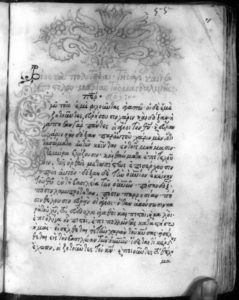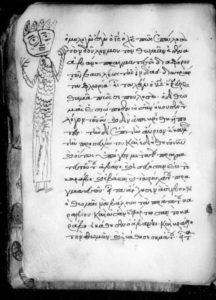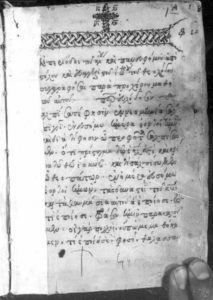Four Uncatalogued Apocrypha Manuscripts from Mount Sinai
Update: the National Library of Israel responded to my query about the origins of their manuscript images. They were part of the same photographing initiative as the Library of Congress, though the library gave the date of this enterprise as 1968, not 1949–1950.
The St. Catherine’s Monastery in the Sinai is well-known as a goldmine of manuscripts—almost 2300 of them in Greek alone, and another 1000 or so in other languages. Its library has yielded such treasures as the Codex Sinaiticus and the Codex Syriacus, along with a number of important manuscripts of apocryphal texts. And it seems to keep giving. In 1975 a number of new leaves and fragments—the so-called “New Finds”—were discovered during the renovation of the tower in the monastery’s north wall. And new technology is being used by the Sinai Palimpsests Project to read the underwriting of reused manuscripts. Recently I made some “new finds” of my own when looking for digitized manuscripts for the NASSCAL project Manuscripta apocryphorum.
The Sinai manuscripts were catalogued in piecemeal fashion in the late nineteenth century. A full list of all the manuscripts, prior to the New Finds, was completed by Murad Kamil in 1970. But this is not a catalogue with full descriptions of each item; Kamil gives only a few lines of information, often describing the manuscripts as simply “Theological Treatises” or “Lives of Saints.”
In 1949–1950 a group of organizations and private scholars joined together to perform a full-scale examination of the monastery’s holdings. The Library of Congress came on the expedition and photographed a large portion of the manuscripts—1687 codices in all, excluding any religious manuscripts past 1600 except for liturgical and canonical texts. A checklist of their work was produced by Kenneth W. Clark in 1952 (available HERE) and the images were made available on the LOC web site a few years ago (HERE). But what of the manuscripts that the LOC did not photograph? Will these be made available?
Well, it seems the National Library of Israel (NLI) has been involved in making that happen. The web site of the library has images of around 1700 Sinai manuscripts, 1200 or so in Greek. No information is given about who is responsible for these photographs and my attempts to find out more have not been successful. The site does not provide much detail about the content of the manuscripts, and Pinakes, which provides links from each manuscript to the NLI images, is also bare in its descriptions. Nevertheless, by using some keyword searches I was able to find four manuscripts containing apocrypha not mentioned in previous scholarship on these texts. I have created Manuscripta apocryphorum pages for each of them and will describe them briefly here.

1. Gr. 1716 (18th cent.). A contents page on fols. 1v–2v provides a complete list of the titles in the manuscript. The relevant texts for us are the Life of Mary Magdalene (fols. 55r–63r; unfortunately, the final page, fol. 63, was not photographed), and the Acts of Philip (fols. 119r–134r). Life Mary Magd. has been published previously by François Halkin from one manuscript (Oxford, Bodleian Library, Holkham gr. 9) and Christine Luckritz Marquis used Halkin’s edition alongside another Sinai manuscript (gr. 20) for her translation of the text forthcoming in MNTA 2. The Pinakes description of gr. 1716 does mention Life Mary Magd. but until now, we did not have access to the manuscript. As for Acts Phil., Pinakes does not mention it, nor does any previous scholarship on the text. The manuscripts of Act Phil. vary considerably in their contents, so it would be of interest to know precisely what is included in this particular manuscript. The remainder of the manuscript is saint’s lives and works by John Chrysostom, Ephrem, Nikandros, and others, along with various patristic texts and the Canon on Easter Sunday.

2. Gr. 1760 (17th cent.). The Pinakes entry for this manuscript does not list any texts at all. Some pages are missing at the start—the manuscript opens on the last page of an unidentified text, and this first folio is numbered (in Greek) KA and KB (21 and 22). The second text is the Acts of Thomas (1v–23v) but in an abbreviated form. The remaining texts are the Life of Hypatius (BHG 795c; fols. 24r–52r), Life of Niphon (BHG 1372a; fols. 53r–87v), some doodles (fol. 88r), Life of Alexios the Man of God (BHG 51–51z; fols. 88v–103v), and Life of John Kalybita (BHG 868–868a; fols. 104r–119v). There are some scribal notes on fol. 52v that might give some details on the manuscript’s production. The copyist scatters various notes throughout the codex and a number of illustrations, most of them human figures.
3. Gr. 1728 (18th cent.). Kamil calls this a “Selection of Anthologies” and Pinakes lists only one title: Prolegomena philosophiae by David the Philosopher (fols. 142r–219r). Useful for our purposes is the Acts of John by Prochorus (fols. 3r–53r). The manuscript begins with an unidentified text (the NLI site calls it “From the Anthologion”; fols. 1r–2v) and the remaining text is a translation of the Metamorphoses (fols. 55r–141r).

4. Gr. 1697 (17th cent.). Kamil, again vague, calls this “Theological Treatises” and Pinakes gives three titles, one of which is an apocryphal text: the Apocalypse of Mary (fols. 217r–232v). The manuscript has been described in previous catalogues, so it has not gone entirely unnoticed. It contains also recension B of the Acts of Pilate (fols. 193r–216v) and the Acts of John by Prochorus (fols. 1r–122r). The remaining texts in this hefty volume include works by John Chrysostom, Menander, the Life of Alexios the Man of God, the Martyrdom of Jacob of Persia, and the Life of Mary of Egypt.
Likely there are other treasures to be found in the NLI’s Sinai photographs, but it would take a considerable amount of time to carefully go through them all. What I have done here is just a start. It is made necessary because of the LOC’s judgment that recent manuscripts, particularly those that feature apocrypha, are not valuable enough to be photographed. But even recent manuscripts can include important witnesses to ancient texts. Thankfully the NLI has now made this material available for everyone to judge the manuscripts for themselves.
